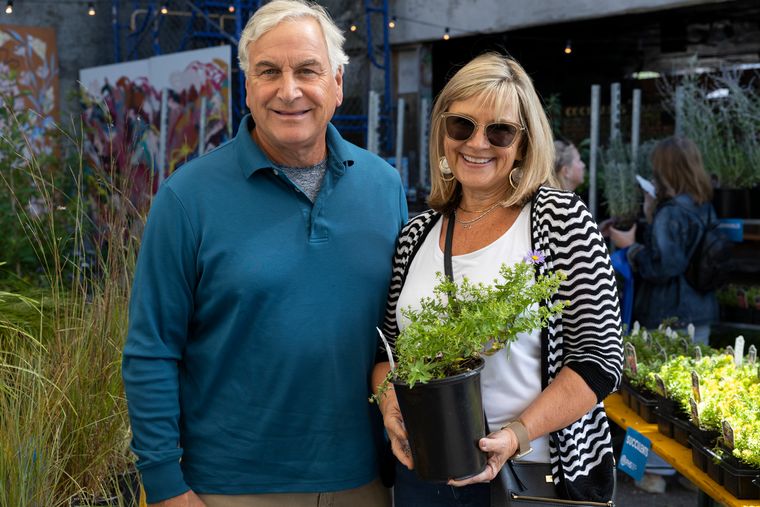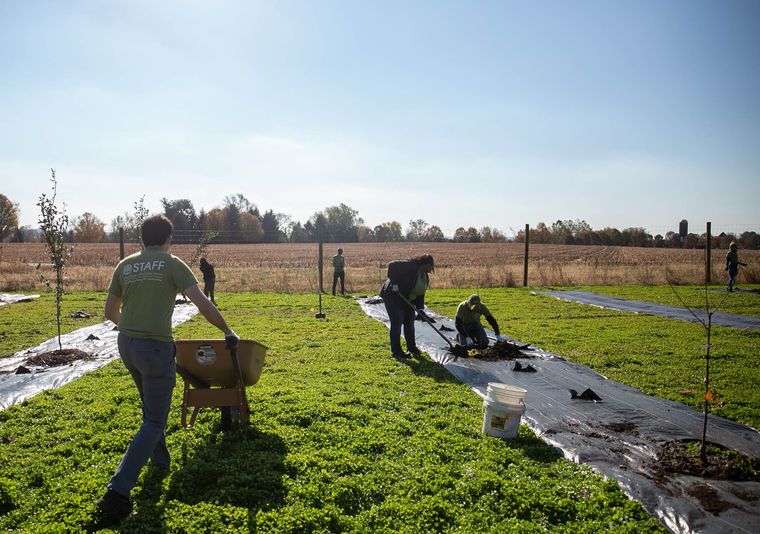



Tomato Growing Tips: Expert Advice from a Self-Proclaimed Tomato Addict
plant care
seasonal tips

By Sally McCabe, Associate Director of Community Education
I’m absolutely obsessed with tomatoes. I’ll do crazy things to get them earlier, help them produce more fruit, and keep them going well into fall. So, I’m always open to learning new tricks and finding ways to maximize production. Some years, I have enough to fill the freezer and pantry. Other years... not so much.
Why I Plant So Many Tomato Varieties
I always plant a wide variety of tomato plants. I want early producers, late finishers, ones that taste great, freeze well, tolerate heat, resist disease, and look gorgeous in a salad. No single variety checks every box, so I usually end up with around 15 different kinds, sometimes even sneaking extra plants into other people’s gardens when I run out of space!
Become a PHS Member for even more expert gardening guides, tips, and inspiration.
How the PHS Team Chooses Tomato Seeds
I asked Emma, our “seed chooser” for the PHS City Harvest Program, how she picks varieties. She listed her top criteria:
- Yield and uniformity
- Flavor and appearance
- Pest and disease resistance
- Resilience
- Shelf life and harvest ease
But my favorite criterion? Whether the variety has a good story. I mean, how can a tomato called Mortgage Lifter be a bad bet?

Tomato Growing Tips for Spring Planting
When I select tomato varieties in spring, I follow many of the same principles as Emma. I try to plant something from each category:
- Open-pollinated varieties – These plants are pollinated naturally (by wind, insects, or hand), and their seeds produce offspring that are true to type. Great for seed saving and regional adaptation (especially after a few generations in Philly’s climate).
- F1 Hybrids – These are the first-generation crosses of two different parent plants, bred to combine the best traits of both. Reliable, uniform, and disease-resistant. My current favorite: Gin Fizz.
- Heirlooms – Full of history and flavor, though sometimes a bit less productive.
- Modern cultivars – Bred for disease resistance, climate adaptability, and consistent yields.
- Instant gratification (my personal favorite) – Varieties like Early Girl or Sub-Arctic Plenty that ripen in 50–60 days. (Yes, I’ll even sneak in a mature plant with fruit already on it to beat the neighbors to the first ripe tomato!)
I also try to plant a second, late crop to keep the tomato train rolling into fall. I like to say it’s intentional, but those who know me might describe my style more as “stuff happens.”
How to Choose Tomatoes for Late-Season Planting
Late-season tomato planting in Zone 7 means working with a ticking clock. With first frost typically hitting in mid-to-late October, you have about 80 to 90 growing days—plenty, if you choose wisely.
Stick to Transplants (Not Seeds)
At this point in the season, it’s best to start with transplants. If you're using seeds, sow them indoors 3–4 weeks ahead.
Prioritize “Days to Maturity”
Choose varieties with a short maturity window, ideally 55 to 70 days. The faster they ripen, the better your chances of beating the frost.
Determinate vs. Indeterminate Tomatoes
Late in the season, determinate or semi-determinate varieties are your best bet. These compact plants flower and fruit all at once. You can grow indeterminate types, especially if they’re early producers, but you may need frost protection in October.
Look for Heat-Tolerant, Disease-Resistant Types
High heat and humidity can stress tomato plants and invite fungal diseases. Choose varieties labeled for heat tolerance and resistance to blight or fusarium wilt.
Best Tomato Varieties for Late Planting
Looking for reliable performers for a late crop? Try these:
- Cherry tomatoes – ‘Juliet,’ ‘Sun Gold,’ ‘Sweet 100’
- Slicers – ‘Bush Early Girl,’ ‘Fourth of July,’ ‘Celebrity’
- Romas – ‘Glacier,’ ‘Roma VF’

Fall Tomato Growing Tips to Stretch the Season
By early September, your plants should be flowering and starting to fruit. Around 4–6 weeks before your first frost, pinch off new flowers to redirect the plant’s energy toward ripening.
If an early frost threatens, use lightweight row covers or floating fabric to protect your plants overnight and buy a little more time.
Yes, I Grew Tomatoes in My Shower. And They Ripened.
Last year, as usual, a whole bunch of leftover seedlings showed up around July 4th. Naturally, I had to find room, so I popped them into the flower bed and hoped for the best. They fruited beautifully into late October and early November. When frost hit, I cut off the vines and dragged them inside to ripen... then promptly forgot about them.
Weeks later, I noticed something red through the glass shower door (don’t judge—nobody uses that bathroom in winter). Sure enough, the vines were still hanging and ripening fruit. Early Girl did okay. Sun Gold looked pretty but tasted like dirt. Still—who else has shower tomatoes that last through New Year’s?
Exploring Storage Tomatoes (Pomodoro d'Inverno)
Turns out, I didn’t invent the idea of hanging tomato vines indoors. This year, thanks to Emma and Sybria from the City Harvest team, I’m trying Italian storage tomatoes, known as pomodoro d’inverno.
These varieties are picked ripe or slightly under-ripe, then hung in clusters. While they don’t have the depth of peak-season tomatoes, they offer bright acidity and a fresh tomato presence well into winter.
I’m growing three varieties from Uprising Seeds:
- Annarita (75 days) – Great for dry heat and can last 6+ months in storage
- Piennolo Rosso – Classic red with intense flavor over time
- Piennolo Giallo – Golden yellow, slightly less long-lasting but supposedly tastier
As the seed catalog puts it: "A welcome diversification of tomato uses for the winter pantry." I couldn’t agree more.
Final Tomato Growing Tip: Mix It Up and Have Fun
Whether you’re growing tomatoes for peak summer eating or winter storage, variety is key. Don’t be afraid to experiment, make mistakes, and sneak a few extras into the flower bed. You might even end up with the best tomatoes in the neighborhood or the best tomatoes in your shower!


